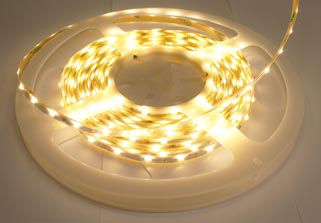Brightness & Illumination – how powerful should my LED strips be?
Light is measured is lumens. That means the more lumens an LED puts out, the more brightly it will light a room. So the question you’ll need to answer is, how big is my room and how many lumens will I need to light it?
Here are some guideline figures, depending on the kind of surface you’re lighting:
- 20 lumens / sq ft for normal (floor) lighting.
- 30 lumens / sq ft for tables and countertops.
- 50 lumens / sq ft for reading and other tasks.
Some examples…
| Example area | Surface type | Estimated lumens required |
| 15 x 20 ft (300 sq ft) | Living room (floor) | 6,000 |
| 4 x 4 ft (16 sq ft) | Dining table | 480 |
| 3 x 3 ft (9 sq ft) | Bedside lamp (reading) | 450 |
See InStyle’s Brightness Range, below, to find out the lumen output of each of our LED tapes.
If walls, furniture or other surfaces are particularly dark colours, then you should increase the brightness of your lights. And your own preferences are important too – personally I prefer things a little bit dimmer, but if you like more light then you’ll want to add another 10 or 20% to the numbers above.
InStyle’s Brightness Range
InStyle supplies LED tape across a range of brightnesses, so you can choose the one that’s right for you. Our strip lights fall into three types:
- Highlight – for features, coving, displays.
- Work/Home – for living rooms, work spaces, domestic lighting.
- Strong – for daylight applications.
| LED colour (Wattage) | Lumens/metre | Brightness |
| White (5 watts) | 420 lm (warm) 450 lm (neutral) 480 lm (pure) |
Highlight |
| White (10 watts) | 840 lm (warm) 900 lm (neutral) 960 lm (pure) |
Work/Home |
| White (12 watts) | 1260 lm (warm) 1350 lm (neutral) 1440 lm (pure) |
Work/Home |
| White (20 watts) | 1680 lm (warm) 1800 lm (neutral) 1920 lm (pure) |
Strong |
| White (24 watts) | 2440 lm (warm) 2620 lm (neutral) 2800 lm (pure) |
Strong |
| Single Colour (5 watts) | 66 lm (blue) 90 lm (red) 90 lm (amber) 210 lm (green) |
Highlight |
| Single Colour (15 watts) | 198 lm (blue) 270 lm (red) 270 lm (amber) 630 lm (green) |
Work/Home |
| Colour Changing (RGB / 7.5 watts) | 540 lm (set to white) |
Highlight |
| Colour Changing (RGB / 15 watts) | 1080 lm (set to white) |
Work/Home |
| Colour Changing (RGBW / 10 watts) | 720 lm (set to full brightness) |
Highlight |
| Colour Changing (RGBW / 20 watts) | 1440 lm (set to full brightness) |
Work/Home |
LED strip lights vs. traditional bulbs
A comparison of lumens output.
The infographic below compares the lumens output by a single traditional bulb to the output of one metre of LED strip lighting. Incandescent and halogen lamps have no optic lens to narrow their beam, so they produce a wide spread of light. Because LED strip lights also produce a wide beam (approx. 120 degrees), this is a good rule-of-thumb comparison.

Lumens vs Illuminance
Lumens are a standardised measurement used to describe the total light output by a light-source. (Sometimes referred to as ‘luminous flux’.)
But if you need to know how brightly a floorspace or other surface area will be lit, then lumens aren’t the right measure. Instead, you should use lux.
Lux values provide a means to measure ‘illuminance’ – which is the intensity of light falling on a particular area. One lux is defined as the illumination that will light a surface one metre from a single candle, which is to say, it’s the light produced by one lumen over an area of one square metre.
The lux value of a light-source on a surface is affected by the source’s beam-angle and its distance from the surface being lit.
- A narrow beam will light a smaller area more brightly, while a wider beam will light a larger area with less intensity;
- A light-source close to the surface being lit will light a smaller area more brightly, while a more distant source will light a larger area with less intensity.
For more information, why not try our handy lumens to lux converter for LED strip lights:
Simply enter the lumen rating (per metre), length and beam-width of your LED strips, and their distance from the floor or surface to be lit. The converter will calculate the approximate lux-equivalent value.
Lux value guidelines:
The table below gives a comparison of approximate lux values for a range of locations/applications:
| Halls, corridors & stairs | 50-150 lux |
| Bedrooms | 100 lux |
| General domestic lighting | 150 lux |
| Restaurants & bars | 250 lux |
| Classrooms | 50-200 lux |
| Kitchens | 150-300 lux |
| Office working light | 400-500 lux |
| Industrial production / factory | 500-750 lux |
| Workshop task lighting | 750-1000 lux |
| Direct sunlight (outdoors) | 30,000-100,000 lux |
Where to install LED highlights
Highlights add accent to a space, by creating complementary lighting tones or drawing attention to features and objects. Here are some examples:
Where to install LED work lighting
Work lighting is the primary illumination in spaces where people will work and live. Homes, offices and similar locations. Here are some examples.

